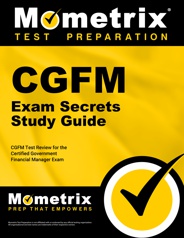The Certified Government Financial Manager (CGFM) is a collection of three exams used by the Association of Governmental Accountants (AGA) to certify professional government financial managers.
Click “Start Test” above to take a free CGFM Certification practice exam, and check out our premium-quality CGFM test prep resources by clicking the links below!
Exam Eligibility
To be eligible to take the exams, you must have at least a bachelors degree in any subject area.
CGFM Exam Outline
The certification program is made of three examinations, all of which must be taken and passed to receive your certification.
There are several acronyms used throughout these exams. Click below to view the official list of acronyms and their definitions.
- AICPA: American Institute of Certified Public Accountants
- ACFR: Annual Comprehensive Financial Report
- CFO: Chief Financial Officer
- CGFM: Certified Government Financial Manager
- COSO: Committee of Sponsoring Organizations of the Treadway Commission
- DATA Act: Digital Accountability and Transparency Act
- ERP: Enterprise Resource Planning
- FASAB: Federal Accounting Standards Advisory Board
- FASB: Financial Accounting Standards Board
- FIFO: First-in, First-out
- GAAP: Generally Accepted Accounting Principles
- GAO: Government Accountability Office
- GASB: Governmental Accounting Standards Board
- GFOA: Government Finance Officers Association
- GPRA: Government Performance and Results Act
- LIFO: Last-in, First-out
- MD&A: Management’s Discussion and Analysis
- OMB: Office of Management and Budget
- OPEB: Other Post-Employment Benefits
- PAR: Performance and Accountability Report
- RSI: Required Supplementary Information
- SEA: Service Efforts and Accomplishments
- SEC: Securities and Exchange Commission
- SFFAS: Statement of Federal Financial Accounting Standards
- SSAE: Statements on Standards for Attestation Engagements
1. Governmental Environment (GE)
This exam contains 115 multiple-choice questions and you will be given a time limit of 2 hours and 15 minutes.
The questions on this exam are split into seven sections:
I. Organization, Structure, and Authority of Government (15%)
- The levels of government
- The branches of government
- The components of local, state, and federal governments
- The authorities and responsibilities of the government
- The authorities and responsibilities of the different types of governments
II. Legally-Based Implications of the Government Financial Environment (15%)
- The implications of sovereignty in the levels of government
- The budget
- The establishment of special funds or dedicated revenues to help fulfill legal requirements
- Legislative earmarking
III. Demonstrate an Understanding of the Government Management System (Cycle) (16%)
- The elements of the government management system
- The interrelationships among the elements of the government management system
- The importance of data in the government management system (cycle)
IV. Governmental Financing Process (24%)
- The role of taxation
- Intergovernmental revenues
- Other forms of financing
- The role of debt
V. Identify the Concepts, Definitions and Notions of Public Accountability (12%)
- Accountability in the government environment
- The role and key attributes of accountability
- Elements for which a government should be accountable
- Primary stakeholders in accountability
- Methods used to demonstrate and assess accountability and transparency
- Techniques used to assess fiscal sustainability and solvency
- Concepts of open government, data transparency, and citizen-centric reporting
VI. Demonstrate an Understanding of Ethics as Applied to the Government Environment (10%)
- Key concepts related to ethical responsibility to the public, professional conduct, and sources of guidance
- Avoiding a conflict of interest as a government financial manager to ensure objectivity and independence
- The concept of due care in the performance of professional duties
- Activities or situations that are inconsistent with the responsibilities of public officials and employees
- The appropriate course of action to avoid the reality or the perception of improper use of one’s office for personal gain
- Personal responsibility as it relates to organizational codes of conduct
VII. Demonstrate an Understanding of Providing Government Services and Information Electronically (8%)
- Delivery of government services and e-government
- Stakeholder real-time access to information
- Using various media and devices for communications and providing services
- Privacy and security considerations
2. Governmental Accounting, Financial Reporting, and Budgeting (GAFRB)
This exam contains 115 multiple-choice questions and you will be given a time limit of 2 hours and 15 minutes.
The questions on this exam are split into three sections:
I. Governmental Financial Accounting, Reporting, and Budgeting: General Knowledge (40%)
- The influences, objectives, and role of standards
- The concepts of managerial cost accounting and fee establishment
- The concepts of budgeting
- General principles of governmental financial accounting
II. Demonstrate an Understanding of State and Local Financial Accounting and Reporting (30%)
- Application of the GASB standards for determining the reporting entity
- The purpose of each fund type within each fund category
- The form and content of the Annual Comprehensive Financial Report (ACFR)
- The purpose of popular reporting
- The form and content of the basic financial statements
- The reporting of fund balance in governmental funds
- The form and purpose of required supplementary information (RSI)
- How to measure, record and report the purchase of capital assets, including assets acquired through a capital lease
- How to measure, record and report the incurrence and repayment of general long-term obligations in a governmental fund
- How to measure, record and report common, fundamental current assets and liabilities, revenue, expenditures, and other financing sources and uses when using modified accrual basis of accounting
- How to measure, record and report common, fundamental assets, liabilities, revenue and expense transactions when using accrual basis of accounting
- The types of interfund transactions
- How to consolidate or eliminate transactions between the fund level and the government-wide level for governmental activities
- The required disclosures for cash deposits with financial institutions and investments, including repurchase agreements
- The option and criteria for using the modified approach for infrastructure
- The entries for recording the budget, modifying the budget, and recording encumbrances and expenditures
- How to reconcile the budgetary information to the generally accepted accounting principles (GAAP) information
- How to reconcile the fund financial statements to the government-wide financial statements
- Government combinations
III. Demonstrate an Understanding of Federal Financial Accounting and Reporting (30%)
- The role of FASAB and the relationships among the Office of Management and Budget (OMB), US Department of the Treasury and the Government Accountability Office (GAO) in federal financial accounting and reporting
- Key budgetary terms
- The components of the budgetary equation
- The relationship and differences between budgetary and proprietary accounting
- Types of funds
- The components and use of the US Standard General Ledger
- How to record common, fundamental budgetary transactions
- How to record common, fundamental proprietary transactions
- Determining the reporting entity
- The form and content of an agency financial report (AFR) and a performance and accountability report (PAR)
- The purposes, form, and content of the basic financial statements
- The concepts of consolidation and intragovernmental transactions
- The purposes and form of the notes to the financial statements
- The purposes and form of required supplementary information (RSI)
- The concept of Fund Balance with Treasury
- The concepts of accounting for loans and loan guarantees (Credit Reform Act)
- The basic requirements for the US Consolidated Financial Report
3. Governmental Financial Management and Control (GFMC)
This exam contains 115 multiple-choice questions and you will be given a time limit of 2 hours and 15 minutes.
The questions on this exam are split into five sections:
I. Financial Management Functions (25%)
- Cash management
- Investment management
- Loan and loan guarantee programs and debt collection
- Procurement management
- Property management
- Operating materials and supplies/inventory management
- Financial management systems
- Shared services
II. Demonstrate an Understanding of Financial and Managerial Analysis Techniques (15%)
- The conduct of various types of analyses
- Sources of information used and reliability of data for financial and managerial analysis
- Forensic techniques
- Advanced data analytics
III. Internal Control (25%)
- Internal control
- Application of internal control
- Internal control responsibilities
- Internal control evaluation process
- Internal control reporting process
- Enterprise Risk Management (ERM)
IV. Demonstrate an Understanding of Performance Measurement/Metrics/Service Efforts and Accomplishments (SEA) (15%)
- The objectives of financial and non-financial performance measures
- How performance measures relate to organizational goals and objectives
- How financial and non-financial performance measures are linked
- How financial and non-financial performance measures are integrated with the strategic plan and budget
- The uses of performance measurement and reporting to demonstrate public accountability and transparency
- The uses of performance measurement and reporting to improve allocation of resources and oversight of performance
- The uses of performance measurement and reporting to improve effectiveness and efficiency
- The types of performance measures
- The characteristics of performance measurement data
- Baselines and benchmarks
- The role of stakeholder input in the performance process
- The legal requirement and guidance for performance measurement
V. Auditing (20%)
- Auditing
- Standards
- The responsibilities of the auditee
- The components of the Single Audit Act
- The role of the Office of Management and Budget (OMB)
Check out Mometrix's CGFM Study Guide
Get practice questions, video tutorials, and detailed study lessons
Get Your Study Guide
Registration
All three exams are computer administered year-round by AGA through Pearson VUE. Once you have been approved into the CGFM program, you will receive a notification allowing you to proceed with the registration and scheduling of your testing appointment. This can be done online or by phone.
The examination fee for each exam is $135.
Test Day
In-person Testing
On test day, you should arrive at the Pearson VUE testing center 15-30 minutes earlier than the scheduled exam time. After you arrive, you will be asked to sign in and present your photo ID to the proctor. You will be photographed and asked to sign a roster and other rule forms.
Personal items such as your cell phone, wallet, keys, and accessories are not allowed in the testing room, so they should be left at home or placed in a secure locker outside the testing area.
Remote Testing
Before the day of the exam, you should ensure your equipment meets the minimum requirements. You must have a desktop or laptop with a webcam and microphone, and you should take your exam in a private workspace. The exam cannot be taken on mobile devices, smartphones, or tablets. The technical requirements can be detailed on Pearson’s website.
On the day of your exam, you will be asked to show the remote proctor your testing space and submit a valid form of photo ID. The proctor will walk you through the examination process after the check-in process is complete.
How the Exam is Scored
Your CGFM exam score is reported as a pass/fail result. Your score is determined using a scaled scoring system that takes your raw score (the number of questions you answered correctly) and converts it to a scaled score on a range of 200 to 700. Your final scaled score must be at least 500 on each exam to pass.
Retaking the Exam
If you do not pass the exam, you may retake it after a 30-day waiting period. You will need to reapply, re-register, and pay the full examination fee for each retake.
Check out Mometrix's CGFM Flashcards
Get complex subjects broken down into easily understandable concepts
Get Your Flashcards
FAQs
Q
How many questions are on the CGFM exam?
A
There are 345 questions in total on the three CGFM exams (115 per exam).
Q
How long is the CGFM exam?
A
The total combined time limit for the exams is 6 hours and 45 minutes (2 hours and 15 minutes per exam).
Q
What is the passing score for the CGFM exam?
A
To pass the exams, you must achieve a minimum scaled score of 500 on each one.
Q
How much does the CGFM exam cost?
A
The examination fee for each exam is $135.
